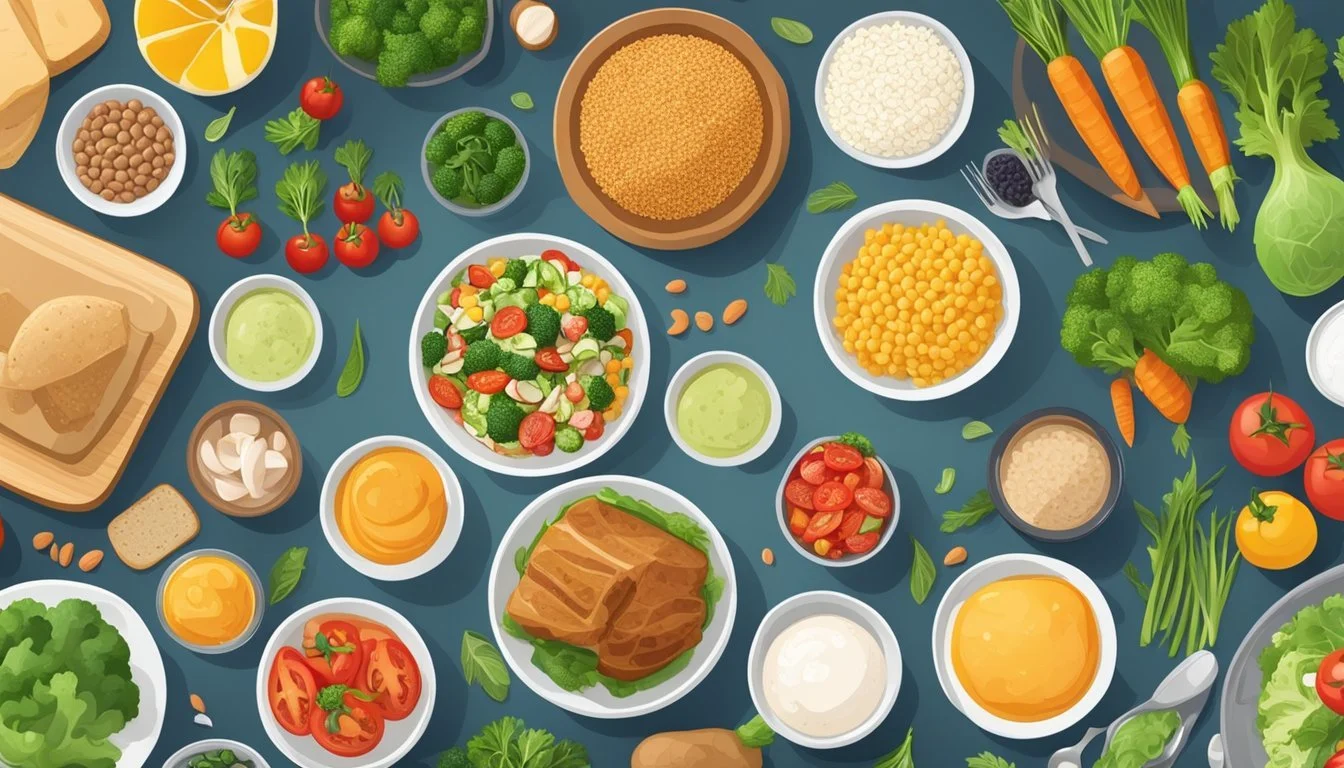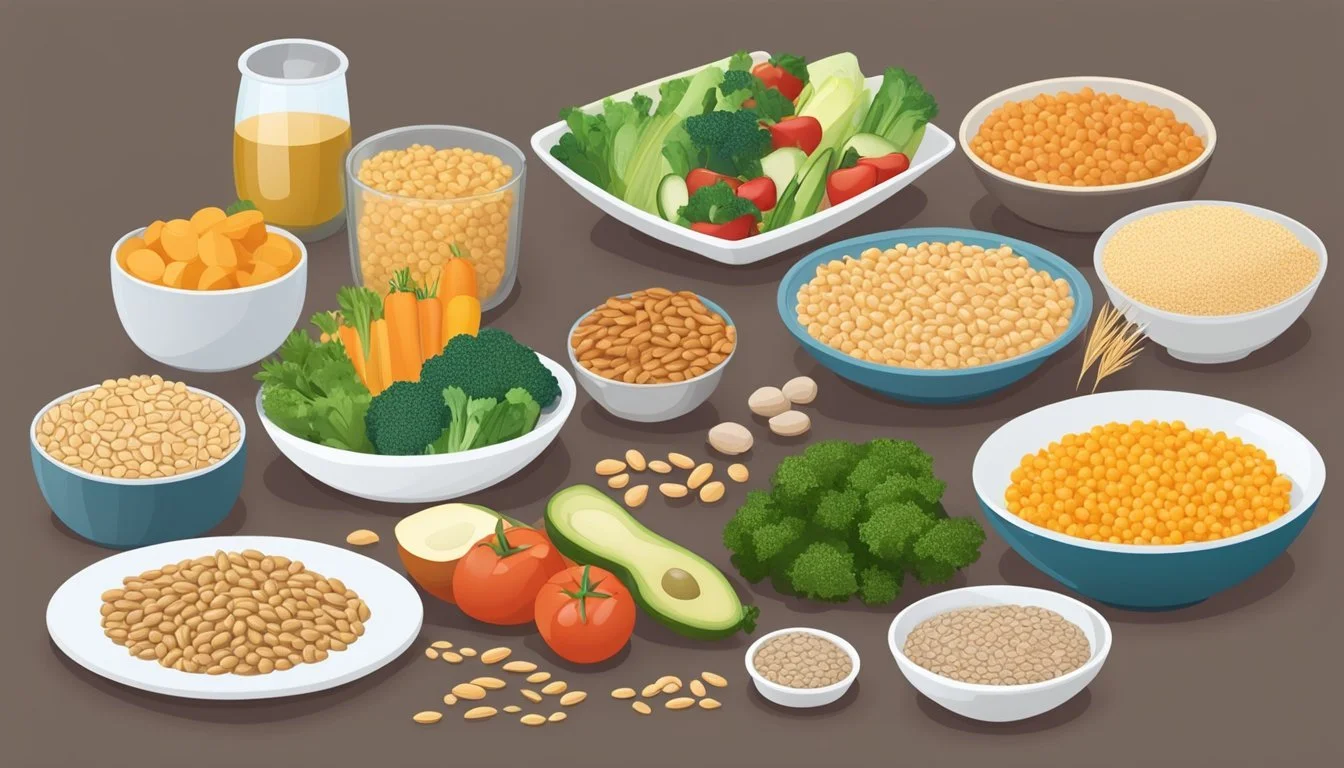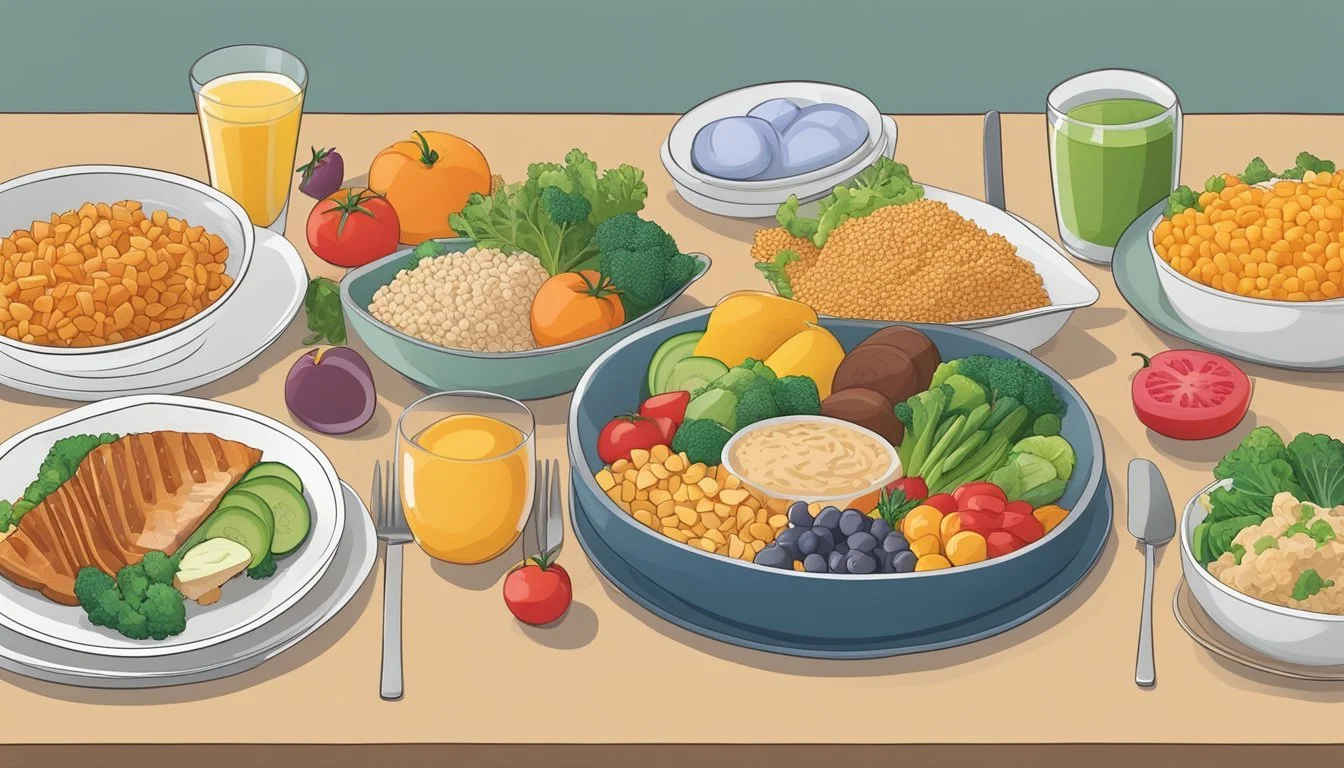Delicious Diabetes-Friendly Dinner Recipes for Type 2 Diabetes
Managing diabetes through diet can be both delicious and nutritious. Dinner recipes tailored for those with diabetes focus on balancing carbohydrates, incorporating lean proteins, and including plenty of vegetables. These meals aim to keep blood sugar levels stable while providing essential nutrients and satisfying flavors.
Many diabetes-friendly dinner recipes can be prepared quickly, making them perfect for busy weeknights. From grilled skewers to one-pot meals, options abound for creating tasty, balanced dishes. These recipes often feature whole grains, lean meats, fish, and an array of colorful vegetables to ensure a well-rounded meal.
Exploring diabetes-friendly dinner recipes can open up a world of culinary possibilities. By learning to cook these meals, individuals with diabetes can enjoy flavorful dinners while maintaining their health goals. With a little creativity in the kitchen, managing diabetes through diet becomes an enjoyable and sustainable part of daily life.
Understanding Type 2 Diabetes
Type 2 diabetes is a chronic condition characterized by high blood sugar levels. It occurs when the body becomes resistant to insulin or doesn't produce enough insulin to regulate glucose effectively.
The hallmark of type 2 diabetes is elevated blood sugar levels. Normal fasting blood sugar is below 100 mg/dL, while diabetes is diagnosed at 126 mg/dL or higher.
A1C tests measure average blood sugar over 2-3 months. An A1C of 6.5% or higher indicates diabetes. For most adults with type 2 diabetes, the target A1C is below 7%.
A diabetes-friendly diet is crucial for managing the condition. This eating pattern focuses on:
Controlling carbohydrate intake
Choosing high-fiber foods
Incorporating lean proteins
Limiting saturated fats and added sugars
Balanced meals help stabilize blood sugar levels. A typical diabetes-friendly plate includes:
1/2 non-starchy vegetables
1/4 lean protein
1/4 whole grains or starchy vegetables
Regular physical activity, medication adherence, and blood sugar monitoring are also key components of diabetes management. With proper care, many people with type 2 diabetes lead healthy, active lives.
Principles of a Diabetes-Friendly Dinner
A diabetes-friendly dinner focuses on balanced nutrition and blood sugar management. Key components include lean proteins, complex carbohydrates, and healthy fats.
Portion control is essential. Using smaller plates can help limit serving sizes naturally. Aim to fill half the plate with non-starchy vegetables, a quarter with lean protein, and a quarter with complex carbs.
Fiber-rich foods are crucial. They slow digestion and help stabilize blood sugar levels. Incorporate whole grains, legumes, and vegetables into meals.
Low-carb options can be beneficial for some individuals with diabetes. Focus on nutrient-dense carbohydrates like quinoa, sweet potatoes, or brown rice in moderate amounts.
Healthy fats from sources like avocados, nuts, seeds, and olive oil support heart health and aid in nutrient absorption. Include small amounts in meals.
Limit sodium intake to support healthy blood pressure. Use herbs and spices for flavor instead of salt.
Cooking methods matter. Opt for grilling, roasting, baking, or steaming rather than frying.
Stay hydrated with water or unsweetened beverages. Avoid sugary drinks that can spike blood sugar.
Consistency in meal timing can help maintain steady blood glucose levels throughout the day.
Choosing the Right Carbohydrates
Selecting appropriate carbohydrates is crucial for managing diabetes. Complex carbs are the preferred choice due to their slower digestion and more gradual impact on blood sugar levels.
Whole grains like brown rice and quinoa offer fiber and nutrients while providing steady energy. These options can be excellent alternatives to refined grains in diabetes-friendly meals.
Vegetables play a vital role in a balanced diabetic diet. Non-starchy vegetables are low in carbs and high in nutrients. Starchy vegetables, while higher in carbs, can still be included in moderation.
Recommended carbohydrate sources:
Whole grains (oats, barley, bulgur)
Legumes (beans, lentils)
Fruits (berries, apples, citrus)
Dairy (plain yogurt, milk)
It's important to limit added sugars in the diet. Reading nutrition labels can help identify hidden sources of sugar in packaged foods.
Portion control remains key when incorporating carbs into meals. Balancing carbohydrates with lean proteins and healthy fats can help maintain stable blood sugar levels throughout the day.
High-Protein Dinner Options
Incorporating lean protein into dinner meals is essential for managing diabetes. Chicken breast is a versatile option that can be grilled, baked, or stir-fried with vegetables for a nutritious meal.
Tilapia offers a mild-flavored fish choice rich in protein and low in saturated fat. It pairs well with whole grains and steamed vegetables for a balanced plate.
Lean ground beef or ground turkey can be used to create flavorful, protein-packed dishes like meatballs or burgers. Opt for 93% lean or higher to minimize saturated fat intake.
Turkey meatballs provide a lighter alternative to traditional beef versions. They can be served with zucchini noodles or whole wheat pasta for a satisfying dinner.
Pork chops, when trimmed of visible fat, offer a lean protein source. Grill or bake them with herbs and serve alongside roasted vegetables.
Salmon is an excellent choice for its high protein content and omega-3 fatty acids. These heart-healthy fats may help improve insulin sensitivity.
Consider plant-based proteins like lentils, beans, or tofu for variety. These options are high in fiber and can help stabilize blood sugar levels.
Remember to balance protein portions with complex carbohydrates and non-starchy vegetables for a well-rounded, diabetes-friendly meal.
Vegetarian Delights
Plant-based meals offer delicious options for managing diabetes. These dishes emphasize nutrient-dense ingredients while keeping carbohydrates in check.
Plant-Based Proteins
Lentils and black beans are excellent protein sources for vegetarian diabetes-friendly dinners. They provide fiber, which helps regulate blood sugar levels. A lentil curry with cauliflower rice offers a satisfying meal rich in nutrients.
Chickpeas make a great base for diabetes-friendly falafels. Pair them with a Greek salad for a complete meal. Quinoa-stuffed bell peppers combine protein and vegetables in one dish.
Incorporating nuts and seeds adds healthy fats and extra protein. Try a spinach and walnut salad with a light vinaigrette dressing.
Tofu and Tempeh Dishes
Tofu and tempeh are versatile soy-based proteins ideal for diabetes management. Marinated tofu stir-fry with mixed vegetables is a quick, nutritious dinner option.
Grilled tempeh kebabs with zucchini and mushrooms make a flavorful main course. Serve with a side of roasted sweet potatoes for a balanced meal.
Tofu scramble with spinach and tomatoes works well for a protein-packed breakfast-for-dinner option. Add turmeric for anti-inflammatory benefits.
Baked tofu slices with a herb crust provide a satisfying texture. Pair with steamed broccoli and brown rice for a complete meal.
Incorporating Healthy Fats
Healthy fats play a crucial role in diabetes-friendly dinner recipes. They help regulate blood sugar levels and promote satiety, making them an essential component of balanced meals.
Olive oil stands out as an excellent source of monounsaturated fats. It can be used for cooking or drizzled over salads to add flavor and nutrition.
Avocados are another powerhouse of healthy fats. They can be sliced and added to sandwiches, mashed into guacamole, or used as a creamy base for sauces.
Other beneficial sources of healthy fats include:
Nuts (almonds, walnuts, pecans)
Seeds (chia, flax, pumpkin)
Fatty fish (salmon, mackerel, sardines)
When incorporating these fats into dinner recipes, moderation is key. A tablespoon of olive oil or a quarter of an avocado can provide ample benefits without excessive calories.
Cooking methods can also impact fat content. Grilling, baking, or roasting with minimal added fats are healthier alternatives to deep-frying.
By thoughtfully including these healthy fats, individuals with diabetes can create satisfying and nutritious dinner options that support their overall health goals.
Herbs and Spices for Flavor
Herbs and spices play a crucial role in enhancing the taste of diabetes-friendly meals without adding extra calories or carbohydrates. They provide a flavorful alternative to salt and sugar, making dishes more satisfying and enjoyable.
Garlic is a versatile ingredient that adds depth to various recipes. It can be used fresh, roasted, or powdered to boost flavor in soups, sauces, and marinades.
Paprika offers a mild, sweet taste with a hint of heat. It works well in rubs for meats, sprinkled on roasted vegetables, or stirred into stews for added color and flavor.
Some herbs that complement diabetes-friendly dishes include:
Basil
Oregano
Cilantro
Mint
Thyme
These herbs can be used fresh or dried to add brightness and complexity to meals.
Spices like cumin, turmeric, cinnamon, and ginger not only enhance flavor but may also offer potential health benefits. They can be incorporated into various cuisines, from Indian-inspired dishes to Mediterranean flavors.
Experimenting with different herb and spice combinations can help create exciting and varied meals while adhering to a diabetes-friendly diet. Always consult with a healthcare provider or registered dietitian for personalized advice on incorporating these flavors into your meal plan.
Salads and Sides
Salads and sides play a crucial role in diabetes-friendly meals. They offer essential nutrients while helping manage blood sugar levels.
Leafy greens form the foundation of diabetes-friendly salads. Spinach and baby spinach are excellent choices, packed with vitamins and minerals.
Lettuce wraps provide a low-carb alternative to traditional sandwiches. Fill them with lean proteins and vegetables for a satisfying meal.
Adding colorful, low-carb vegetables enhances both nutrition and visual appeal. Consider cucumbers, bell peppers, mushrooms, and radishes.
Protein sources like grilled chicken, hard-boiled eggs, or tofu can transform a side salad into a hearty main course.
Healthy fats from avocados or nuts contribute to satiety and help with nutrient absorption.
For dressings, opt for vinaigrettes made with olive oil and vinegar. Avoid sugary or creamy dressings that can spike blood sugar.
Sides like roasted vegetables or quinoa salads offer variety and additional nutrients. Choose non-starchy vegetables and whole grains in moderation.
Portion control remains important. Even healthy options should be consumed in appropriate amounts to maintain stable blood sugar levels.
Creative Dinner Recipes
Diabetes-friendly meals can be both nutritious and exciting. These innovative recipes offer flavorful options that fit seamlessly into a balanced diet for managing blood sugar.
Sheet Pan Appeals
Sheet pan dinners simplify cooking while delivering delicious results. Try roasting a mix of colorful vegetables like bell peppers, zucchini, and Brussels sprouts with lean protein such as chicken breast or salmon. Season with herbs and a drizzle of olive oil for a complete meal.
For a Mediterranean-inspired dish, combine cherry tomatoes, red onions, and cubed eggplant with cumin-spiced chickpeas. This plant-based option provides fiber and protein without excess carbs.
Sheet pan fajitas offer a fun twist on Tex-Mex cuisine. Slice bell peppers, onions, and lean beef or tofu, then season with chili powder and lime juice before baking.
One-Pot Wonders
One-pot meals minimize cleanup while maximizing flavor. A veggie-packed chili made with ground turkey, beans, and diced tomatoes offers a hearty option rich in protein and fiber.
Experiment with curry dishes using cauliflower rice as a low-carb base. Add coconut milk, curry powder, and a mix of vegetables like spinach and chickpeas for a satisfying meal.
Skillet meals shine in diabetes-friendly cooking. Try a Spanish-inspired dish with chicken, bell peppers, and tomatoes, seasoned with smoked paprika and garlic. Serve with a small portion of brown rice for added nutrients.
Low-Sodium Flavor Boosters
Reducing sodium intake is crucial for managing diabetes, but it doesn't mean sacrificing flavor. There are many ways to enhance the taste of diabetes-friendly meals without relying on salt.
Herbs and spices are excellent low-sodium flavor boosters. Fresh or dried basil, oregano, thyme, and rosemary can add depth to dishes. Garlic powder, onion powder, and black pepper are versatile options that complement a wide range of recipes.
Citrus fruits offer a bright, tangy kick. Lemon juice can brighten up salads, vegetables, and proteins. Orange or lime zest can infuse dishes with intense flavor without adding extra sodium.
Vinegar is another powerful flavor enhancer. Balsamic, apple cider, or red wine vinegar can be used in marinades, dressings, and sauces to add complexity and acidity.
Roasting vegetables intensifies their natural flavors. This technique brings out the sweetness in carrots, bell peppers, and onions without the need for added salt.
Here are some low-sodium flavor boosters to try:
Fresh herbs (basil, cilantro, parsley)
Citrus juices and zests
Vinegars (balsamic, apple cider, rice)
Garlic and onion (fresh or powdered)
Spices (cumin, paprika, turmeric)
Experimenting with these ingredients can create flavorful, diabetes-friendly meals without excess sodium.
Vegetable-Centric Mains
Vegetable-based main dishes offer delicious and satisfying options for those managing diabetes. These meals focus on nutrient-dense, low-carb vegetables while providing essential proteins and healthy fats.
Cauliflower takes center stage in many diabetes-friendly recipes. Roasted cauliflower steaks or cauliflower rice bowls topped with lean proteins make excellent choices.
Zucchini noodles, or "zoodles," serve as a low-carb pasta alternative. Toss them with tomato sauce, herbs, and grilled chicken for a flavorful meal.
Zucchini lasagna replaces traditional pasta sheets with thinly sliced zucchini. Layer it with ricotta, spinach, and a vegetable-packed tomato sauce for a comforting dish.
Stuffed vegetables offer versatility and nutrition. Bell peppers or tomatoes filled with quinoa, beans, and vegetables provide a balanced meal rich in fiber and protein.
Stir-fries combining an array of colorful vegetables with tofu or tempeh create quick, diabetes-friendly dinners. Include bell peppers, onions, and snap peas for added crunch and nutrients.
Vegetable-based curries using cauliflower, tomatoes, and spinach paired with chickpeas offer a protein-rich, flavorful option. Serve with a small portion of brown rice for a complete meal.
Mindful Meal Planning
Meal planning is a crucial aspect of managing diabetes through diet. A well-structured plan incorporates diabetes-friendly recipes that help control blood sugar levels.
When creating a meal plan, focus on balanced nutrition. Include lean proteins, non-starchy vegetables, whole grains, and healthy fats in each meal. This combination supports steady glucose levels throughout the day.
Portion control plays a key role in diabetes management. Use measuring tools or visual cues to ensure appropriate serving sizes. This helps prevent blood sugar spikes after meals.
Consider the glycemic index of foods when selecting recipes. Choose ingredients that have a lower impact on blood glucose. Whole grains, legumes, and most vegetables are excellent options.
Prep meals in advance to make weeknight dinners easier. Cook large batches of diabetes-friendly recipes and portion them out for the week. This strategy saves time and reduces the temptation to choose less healthy options.
Variety is important in any meal plan. Rotate between different diabetes-friendly dinner recipes to keep meals interesting. This approach helps maintain motivation and adherence to the plan.
Remember to account for occasional treats in the meal plan. Moderation is key, and planning for small indulgences can prevent feelings of deprivation.
Healthy Fats and Oils
Incorporating healthy fats and oils into diabetes-friendly dinner recipes is essential for balanced nutrition. These fats provide important nutrients and can help manage blood sugar levels.
Olive oil stands out as an excellent choice for cooking and dressing dishes. Rich in monounsaturated fats, it offers potential benefits for heart health and glycemic control.
Other healthy fat sources include:
Avocados
Nuts (almonds, walnuts)
Seeds (chia, flax)
Fatty fish (salmon, mackerel)
These ingredients can be easily incorporated into diabetes-friendly meals. For example, adding sliced avocado to salads or using olive oil for sautéing vegetables.
Moderation is key when using fats and oils. While beneficial, they are calorie-dense. A general guideline is to limit added fats to 1-2 tablespoons per meal.
When cooking, opt for methods that require minimal added fats. Grilling, roasting, or steaming are excellent techniques for preparing flavorful, diabetes-friendly dinners.
By thoughtfully including healthy fats and oils, individuals with diabetes can create satisfying meals that support their overall health and blood sugar management goals.
Immunity Boosting Ingredients
Incorporating immunity-boosting ingredients into diabetes-friendly dinner recipes can support overall health. Vitamin C plays a crucial role in immune function and can be found in various foods.
Citrus fruits, particularly lemons, are excellent sources of vitamin C. Adding a splash of lemon juice to dishes not only enhances flavor but also provides an immunity boost.
Other vitamin C-rich ingredients include bell peppers, broccoli, and Brussels sprouts. These vegetables can be easily incorporated into stir-fries or roasted as side dishes.
Garlic and ginger are known for their immune-supporting properties. They can be used to add flavor to soups, stews, and marinades.
Turmeric, often found in curry dishes, contains curcumin, which has anti-inflammatory properties. It pairs well with cauliflower and lentils in savory meals.
Leafy greens like spinach and kale are packed with nutrients that support immune health. They can be added to salads or sautéed as a side dish.
Mushrooms, especially shiitake and maitake varieties, contain beta-glucans that may enhance immune function. They can be grilled, sautéed, or added to soups.
Managing Blood Sugar
Controlling blood sugar is crucial for people with diabetes. Monitoring glucose levels regularly helps guide food choices and medication needs.
Eating a balanced diet with complex carbohydrates, lean proteins, and healthy fats can help stabilize blood sugar. Foods high in fiber, like vegetables and whole grains, slow digestion and prevent rapid spikes.
Portion control is key. Using smaller plates and measuring servings helps avoid overeating. Spreading meals and snacks throughout the day maintains steadier glucose levels.
Exercise plays a vital role in blood sugar management. Physical activity increases insulin sensitivity, allowing cells to use glucose more effectively. Even a 10-minute walk after meals can make a difference.
Staying hydrated is important. Water helps flush excess glucose through urine. Unsweetened beverages are best, as sugary drinks can cause blood sugar surges.
Stress management techniques like deep breathing or meditation can help. Stress hormones can raise blood glucose levels, so finding ways to relax is beneficial.
Getting adequate sleep supports blood sugar control. Lack of sleep can affect hormone balance and insulin sensitivity. Aim for 7-9 hours per night.
Magnesium-rich foods may improve insulin function. Good sources include leafy greens, nuts, seeds, and whole grains.
Desserts and Sweet Treats
Satisfying a sweet tooth while managing diabetes is possible with the right recipes. Diabetic-friendly desserts focus on complex carbohydrates and moderate sugar content.
Fresh fruit makes an excellent natural sweet treat. Grilled peaches topped with blueberries offer a simple, delicious option with no added sugars.
Sugar-free gelatin desserts can be a light, low-carb choice. While not particularly nutrient-dense, they provide a sweet fix without impacting blood sugar significantly.
For more substantial desserts, consider recipes that incorporate whole grains and limit added sugars. Ribbon pudding pie with layers of vanilla, chocolate, and butterscotch can be adapted to fit diabetic needs.
Baked goods like oat-based apple crumbles or peanut butter swirl brownies made with alternative sweeteners can satisfy cravings while maintaining blood sugar control.
When selecting dessert recipes, look for those that:
Use complex carbohydrates
Incorporate fruit for natural sweetness
Utilize sugar substitutes when needed
Include protein or healthy fats to slow sugar absorption
By choosing wisely, people with diabetes can enjoy occasional sweet treats as part of a balanced diet.













